Analyzing Job Tenure Trends Over the Years: Insights from CapRelo
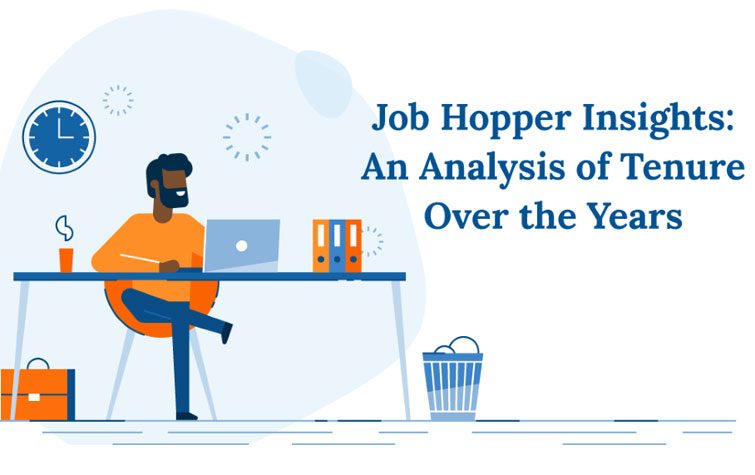
In 2020, most employees appeared settled in their roles, seemingly unaffected by the pandemic’s disruptions. However, the HR community began to anticipate a significant shift. This shift was validated when more than 4 million employees quit their jobs in April 2021 alone, according to the Bureau of Labor Statistics.
Whether driven by burnout, dissatisfaction with their roles, or a reevaluation of work-life balance, a significant number of employees are
The average employee tenure by industry reveals underlying trends in workforce behavior and stability that can significantly influence organizational strategies. For instance, industries like healthcare and education often benefit from longer tenures, potentially due to the intrinsic value and societal contribution associated with careers in these fields. On the other hand, sectors such as information technology and retail trade exhibit shorter tenures, likely driven by the fast-paced evolution within technology and the flexible nature of retail employment, respectively.
These distinctions offer companies insights into crafting targeted retention strategies, aligning employee development programs with the unique demands and expectations of their industry segment, thereby fostering a more committed and satisfied workforce.
choosing to leave their positions. At CapRelo, our mission is to assist companies and their employees with relocation, ensuring a smooth transition and job satisfaction. Thus, the recent surge in job vacancies, dubbed “the great resignation” by psychologist and Harvard professor Anthony Klotz, is particularly relevant to our work.
At CapRelo, we specialize in helping companies and their employees relocate, which often involves keeping employees invested in their jobs and happy and unstressed as they embark on their career or location transition. With that in mind, the ongoing surge of job vacancies —or “the great resignation” as psychologist and Harvard professor Anthony Klotz coined it—is very meaningful to us and our clients.
But are people really leaving their jobs more than they used to? Which employee demographic is most at risk? We decided to map out the average tenure of employees across age and gender and see what trends emerged over time.
Methodology
To track employee tenure over time, we turned to publicly available data from the Bureau of Labor Statistics. We pulled the median years of tenure with the current employer for employed wage and salary workers for the month of January in 2010, 2012, 2014, 2016, 2018 and 2020. We then analyzed this data by age group of employees, from 18-19 up to 65+, as well as by gender, industry and occupation. This yielded a clear picture of tenure across various planes of the workforce.
Key Findings
Tenure by Age and Gender
- Millennials and Job Hopping: The average tenure for Millennials is 4 years, with the lowest tenure among 25-34-year-olds at just 3 years.
- Overall Decline in Tenure: The median tenure for employees aged 18 and older decreased slightly from 5.5 years in 2010 to 5.4 years in 2020.
- Gender Differences: Women tend to have a shorter average tenure (4.7 years) compared to men (5 years).
Industry and Occupation Insights
- Highest Tenure by Industry: Manufacturing (5.6 years), Insurance (5.5 years), and Healthcare (5.4 years) showed the highest median years of tenure in the private sector.
- Management and Tenure: Occupations in management have some of the highest median years of tenure at 6.3 years.
Job Hopping by Age and Gender
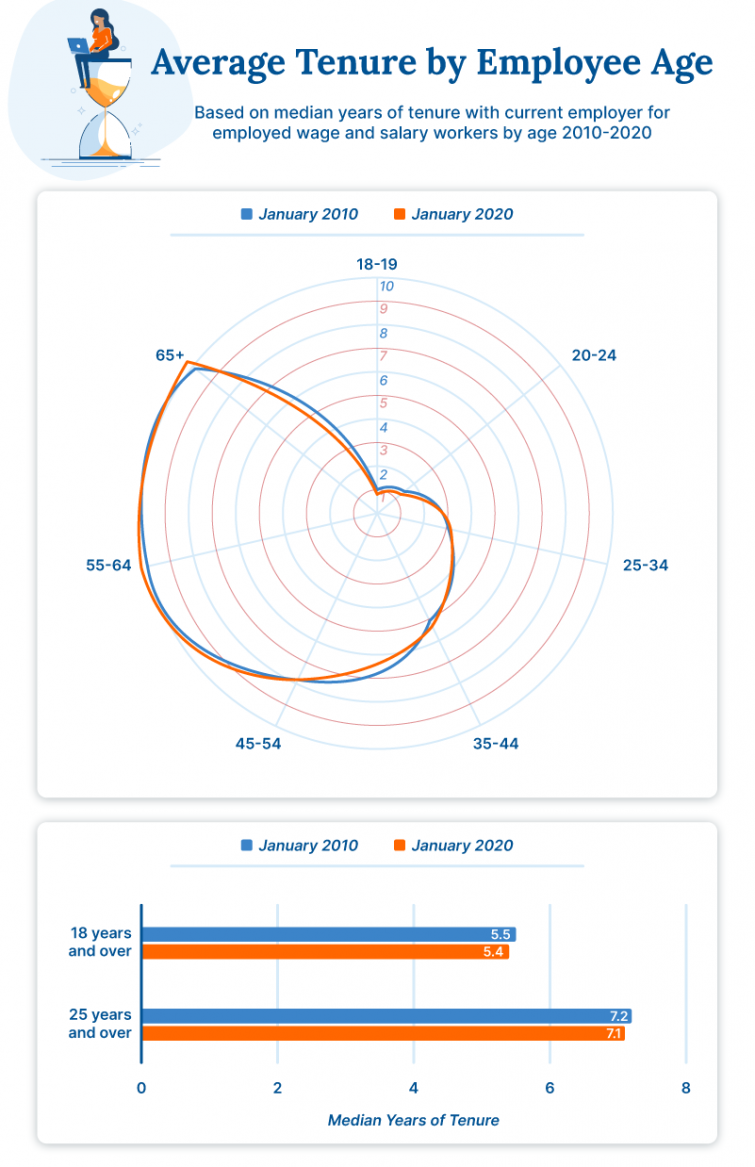
Probably to no surprise, the data showed that younger employees change jobs much more frequently than older employees. Averaging the median years of tenure from 2010 to 2020, we saw an increase for every consecutive age group we measured. For example, employees who are 20-24 have an average median tenure of just 1.3 years while employees who are 45-54 have an average median tenure of 7.2 years. As you can see from the graph above, the pattern was very pronounced, with 18-19 year-olds staying with an employer for 0.8 years on average, 20-24 year-olds staying for 1.3 years, 25-34 year-olds staying for 3.0 years and so on.
Median tenure dropped not only by age group but also over time, with employees aged 25 and over averaging 7.1 years in 2020 down from 7.2 years in 2010. When including employees aged 18 and over, the entire range dropped slightly, rendering the median tenure 5.5 years in 2010 and 5.4 years in 2020.
This suggests that frequent job-hopping isn’t necessarily an acute issue brought on by the pandemic or other immediate economic stimuli. Rather, it’s a generational shift, where younger employees are prioritizing different aspects of work culture and looking for those larger career jumps and skill development.
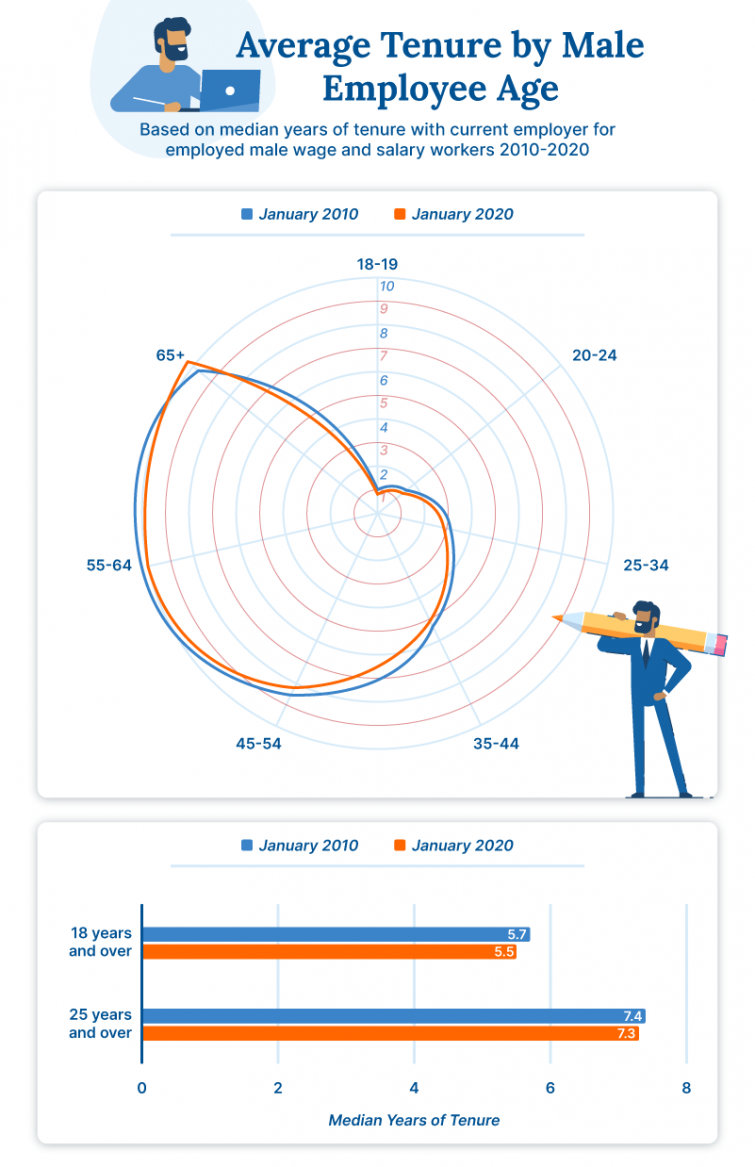
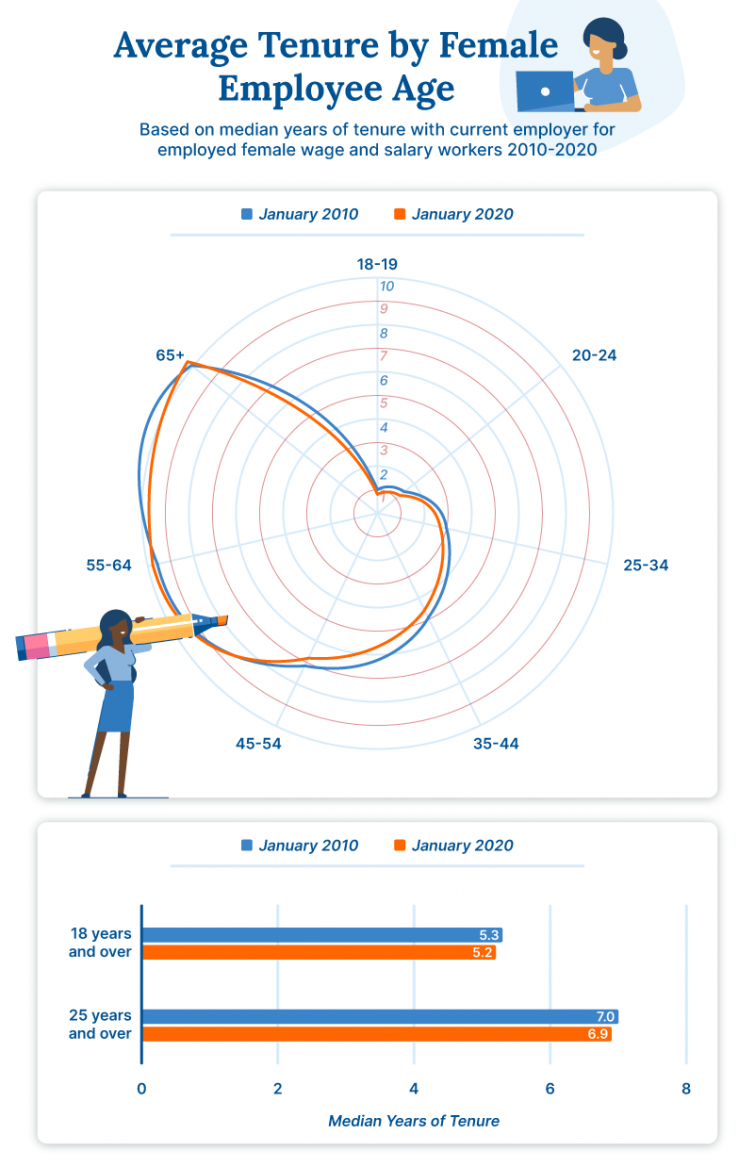
In light of DEI&B, we next wanted to evaluate gender differences in average length of employment. While the overall pattern of increasing tenure with increasing age held true, there were some minor differences between male and female tenures.
Women are just slightly more eager to find a better fit with an average median tenure (from 2010-2020) of 4.7 years compared to the mens’ average median tenure of 5.0 years for the same timeframe. This was especially noticeable within millennial employees (aged 25-44) with women averaging a median of 3.9 years and men averaging 4.1 years across the decade of 2010-2020.
We still saw the median tenure decrease from 2010 to 2020 for both men and women. Notably, the average tenure for women 25 years and older declined from 7.0 years in January 2010 to 6.9 years a decade later. With men and women following the general trend of slightly decreased tenure over time and drastically decreased tenure by generation, we turned our sights to the variables of industry and occupation for further insights on employee behavior.
Job Hopping by Industry
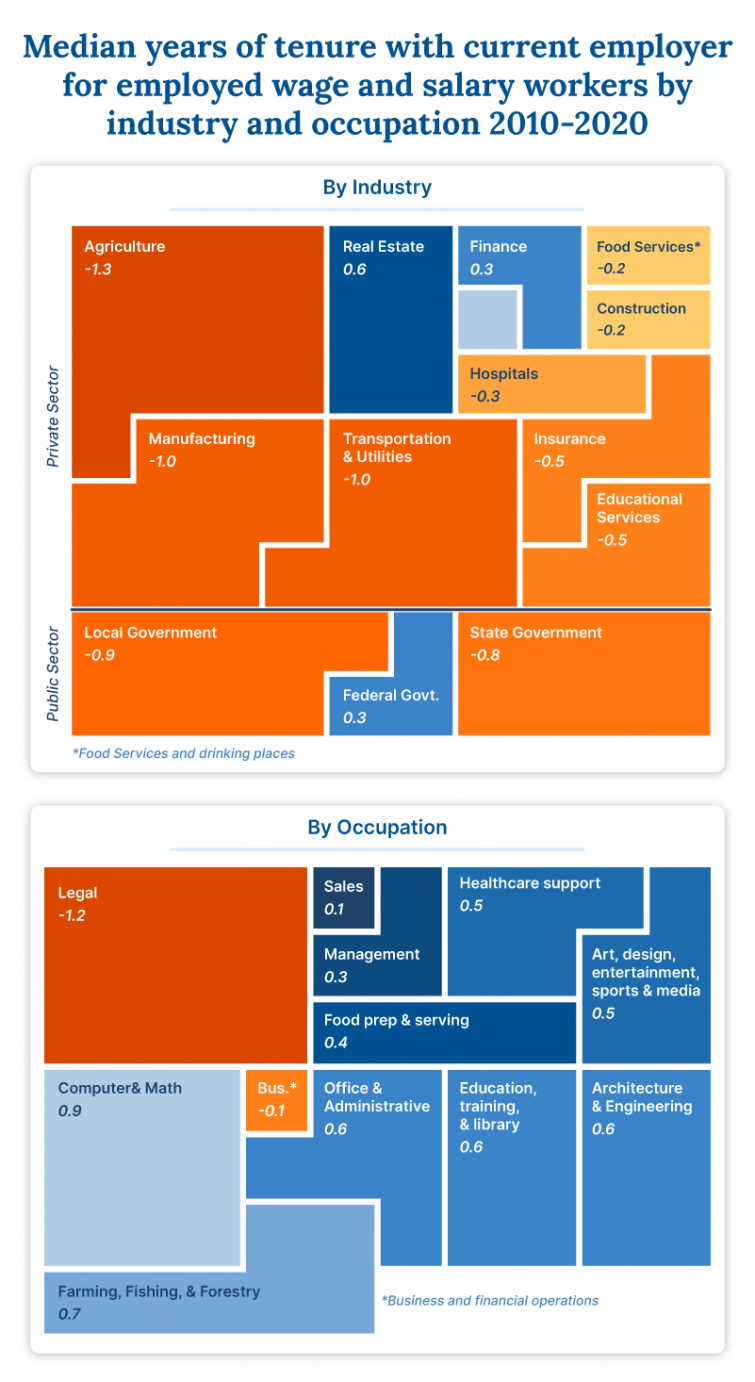
Manufacturing, Insurance and Healthcare workplaces show the highest median years of tenure for the private sector jobs researched, with employees staying at a single job for 5.6, 5.5 and 5.4 years respectively. While the exact reason for remaining in these roles is unknown, it’s possible that these industries may provide higher job satisfaction, better benefits and a better work/life balance.
It’s also possible that with advanced degrees, individuals stay with an employer to grow their practical skills. Per the data, occupations like Architecture and Engineering have higher median years of tenure, which is understandable as these careers require extensive education and dedication which typically increases the financial gain.
New Insights into Employee Tenure by Industry
The average employee tenure by industry reveals underlying trends in workforce behavior and stability that can significantly influence organizational strategies. For instance, industries like healthcare and education often benefit from longer tenures, potentially due to the intrinsic value and societal contribution associated with careers in these fields. On the other hand, sectors such as information technology and retail trade exhibit shorter tenures, likely driven by the fast-paced evolution within technology and the flexible nature of retail employment, respectively.
These distinctions offer companies insights into crafting targeted retention strategies, aligning employee development programs with the unique demands and expectations of their industry segment, thereby fostering a more committed and satisfied workforce.
What does this mean for relocation practices? At CapRelo, we know that relocation programs and policies are not one size fits all. Each organization needs to assess their unique employee’s needs according to their career trajectory, best practices and lifestyle to ensure positive talent recruitment and retention. We work with our clients to develop policies that advance their talent management agendas with the best outcome for the employee in mind – whether that’s long term, short term, business traveler, core-flex, lump sum or no policy!
See the graphic above to learn how average tenure for these industries and occupations has changed over time. Average tenure dropped during this decade for every industry researched except for two in the private sector—finance and real estate—and one in the public sector—the federal government.
For specific occupations, we saw the reverse. Most careers showed increased tenure, albeit by a small amount—just 0.3 years on average. Only two occupations showed decreased tenure over time, business and financial services and legal jobs, which dropped by 0.1 and 1.2 years, respectively.
Higher skilled jobs like engineering or management may have a longer tenure due to dedication to the company or desire for career growth and are more likely to be retained after an assignment with proper repatriation and growth.
Our analysis reveals several key trends:
- Younger generations tend to change jobs more frequently than older generations.
- Higher-skilled occupations often have longer tenure, likely due to the dedication and education required.
- The overall decline in tenure is gradual and may be more indicative of generational shifts than immediate economic conditions.
Regardless of the causes behind these trends, employers must adopt robust talent management strategies to navigate the evolving job market. At CapRelo, we are committed to helping our clients achieve optimal outcomes through tailored relocation and talent management solutions.



